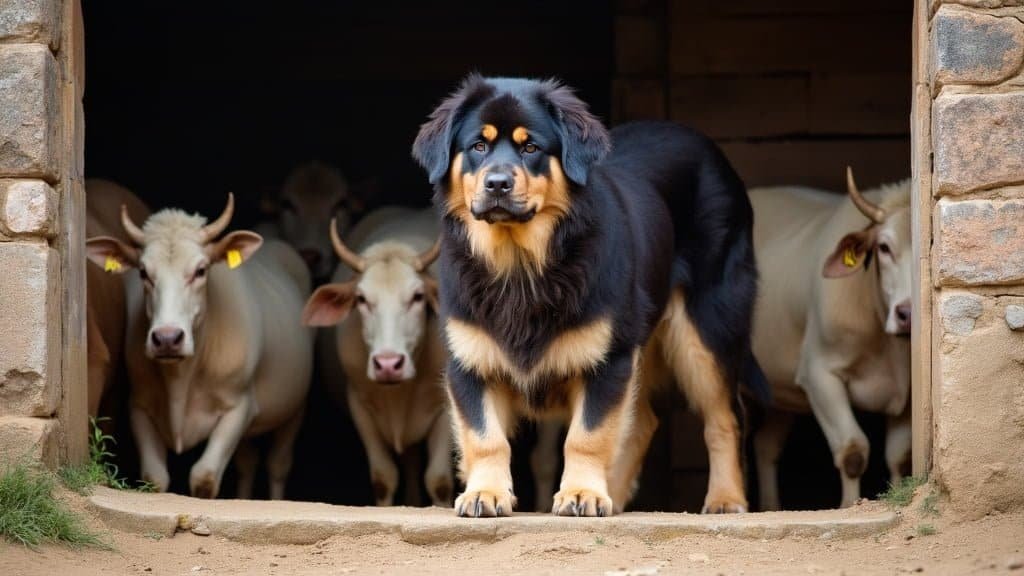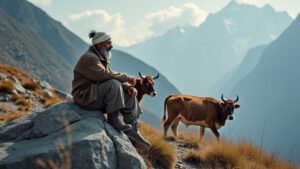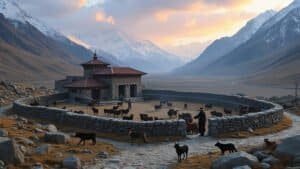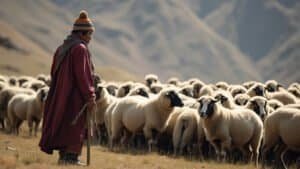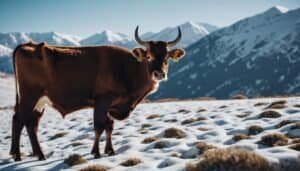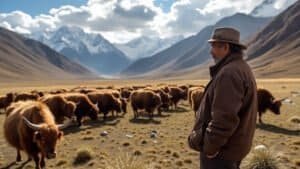Introduction
Conservationists face significant challenges in addressing the conflict between snow leopards and livestock. As these elusive predators often target domesticated animals, protecting local livelihoods while ensuring the survival of snow leopards is crucial
This article will explore the various protective measures employed to safeguard livestock, the role of local communities in conservation efforts, and the technological innovations that aid in mitigating these conflicts
We will also examine how conservationists balance the needs of both wildlife and human populations, ensuring a sustainable future for snow leopards and the communities that share their habitat
Protective Measures for Livestock Against Snow Leopards
Conservationists employ a variety of strategies to protect livestock from snow leopards, aiming to reduce conflict and prevent retaliatory killings of these endangered cats
Protecting livestock not only ensures the livelihood of local communities but also contributes to the broader goal of conserving snow leopard populations
The following sections explore the key protective measures utilized, including physical barriers, the use of guard animals, and improved livestock management practices
Fencing and Enclosures
Fencing and enclosures are among the most effective methods to protect livestock from snow leopards. These physical barriers are designed to prevent the predators from accessing vulnerable animals, particularly at night when attacks are most likely to occur
In many regions, traditional enclosures made from wood or stone have been reinforced or replaced with more secure options, such as predator-proof corrals. These corrals are constructed with high walls and roofs made of strong materials like chain-link fencing, which are difficult for snow leopards to breach
One successful initiative is the use of “Foxlights,” an innovative deterrent developed in Australia and adapted for use in snow leopard habitats
Foxlights are solar-powered, flashing lights that mimic human presence, deterring predators from approaching livestock enclosures. Studies conducted in regions like Mongolia and Nepal have shown a significant reduction in livestock predation where Foxlights have been deployed
Use of Guard Animals
The use of guard animals, particularly dogs, is another effective strategy in preventing snow leopard attacks on livestock
Guard dogs are trained to protect herds by barking and physically confronting predators, often deterring them from attacking. Breeds such as the Tibetan Mastiff, known for their strength and protective instincts, are commonly used in regions where snow leopards are present
In Kyrgyzstan, for example, a project led by the Snow Leopard Trust has reintroduced traditional guard dogs to local herding communities. This initiative not only helps protect livestock but also revives cultural practices that have been lost over time
According to reports from the project, herders have observed a noticeable decline in livestock losses since the introduction of guard dogs, demonstrating the effectiveness of this age-old method
Livestock Management Practices
Improving livestock management practices is a crucial aspect of reducing snow leopard-livestock conflicts
Conservationists encourage herders to adopt practices that minimize the risk of predation, such as keeping livestock in well-guarded enclosures at night and grazing animals in safer, less isolated areas during the day
In some regions, herders are trained to monitor the behavior of their animals and identify signs of predator presence, allowing them to take preventive actions before an attack occurs
Additionally, rotational grazing, where livestock are moved between different pastures throughout the year, helps to reduce the likelihood of encounters with snow leopards. This practice not only keeps livestock safe but also supports the health of the rangelands, benefiting the overall ecosystem
Conservation organizations like Panthera and the Snow Leopard Trust have been instrumental in promoting these improved management practices
Their work involves training programs, providing resources, and conducting ongoing research to refine and adapt strategies to the specific needs of different regions. By working closely with local communities, these organizations ensure that livestock management practices are sustainable and culturally appropriate, increasing their acceptance and effectiveness
Community Involvement in Snow Leopard Conservation
Community involvement is a cornerstone of snow leopard conservation efforts. By engaging local communities, conservationists aim to foster a sense of stewardship over snow leopard populations while addressing the economic needs and concerns of those living in proximity to these predators
This section explores the critical role that education, community-based conservation initiatives, and incentive programs play in ensuring the coexistence of humans and snow leopards
Education and Awareness Programs
Education is a powerful tool in snow leopard conservation, helping to shift local attitudes and behaviors toward wildlife. Many communities living in snow leopard habitats have traditionally viewed these predators as threats to their livelihoods, leading to conflict and retaliatory killings
To counter this, conservationists have developed educational programs that raise awareness about the ecological importance of snow leopards and promote non-lethal methods of conflict resolution
For example, in Nepal, the Snow Leopard Conservancy and other organizations have implemented school outreach programs that teach children about snow leopard ecology and the importance of biodiversity
These programs often include field trips, interactive lessons, and cultural activities that highlight the significance of snow leopards in local traditions. By educating the younger generation, these initiatives help cultivate a conservation ethic that extends into the broader community
Additionally, adult education programs focus on training herders and farmers in practices that minimize conflicts with snow leopards. Workshops and community meetings provide a platform for sharing knowledge and experiences, encouraging the adoption of protective measures such as improved enclosures and the use of guard animals
Community-Based Conservation Initiatives
Community-based conservation initiatives are at the heart of many successful snow leopard protection efforts. These initiatives involve local people directly in conservation activities, empowering them to take ownership of wildlife protection and benefit from the outcomes
One of the most well-known examples is the formation of community conservation committees or “Snow Leopard Conservation Committees” (SLCCs) in regions like Pakistan, India, and Mongolia
These committees are composed of local stakeholders, including herders, village leaders, and representatives from conservation organizations. They work collaboratively to develop and implement strategies that reduce human-wildlife conflict, such as creating predator-proof livestock enclosures, monitoring snow leopard populations, and conducting anti-poaching patrols
The involvement of local people in these initiatives ensures that conservation measures are culturally appropriate and more likely to be accepted and sustained over the long term
In addition to protecting snow leopards, these initiatives often generate economic benefits for communities. For instance, in some areas, SLCCs have established ecotourism ventures that provide income for local families while raising awareness about snow leopard conservation
Tourists are drawn to the opportunity to see snow leopards in the wild, and their spending on local services supports community development
Incentives and Compensation Schemes
Incentive and compensation schemes play a crucial role in mitigating the economic impact of snow leopard predation on livestock
These programs offer financial compensation to herders who lose animals to snow leopards, reducing the likelihood of retaliatory killings. Compensation can take various forms, including direct payments, insurance schemes, or in-kind support such as livestock replacement
One example is the Livestock Insurance Program run by the Snow Leopard Trust in Mongolia. Under this program, herders pay a small premium to insure their livestock against predation
If a snow leopard kills an insured animal, the herder receives compensation from the program, funded by the premiums and supported by conservation organizations. This approach not only alleviates the financial burden on herders but also encourages them to support snow leopard conservation, as the program’s success depends on the continued presence of these predators
Another incentive-based approach is the “conservation reward” system, where communities receive financial rewards for maintaining healthy snow leopard populations
This system ties economic benefits directly to the presence of snow leopards, making their protection a community priority. Conservationists have observed that these schemes significantly reduce the incidence of retaliatory killings, as communities become active partners in protecting snow leopards
Technological Solutions to Snow Leopard-Livestock Conflicts
Technology has become an increasingly important tool in the effort to reduce conflicts between snow leopards and livestock
Conservationists are leveraging advancements in GPS tracking, automated deterrence systems, and drone technology to monitor snow leopard populations, prevent predation, and ensure the safety of both livestock and wildlife
This section delves into how these technological solutions are being applied in snow leopard habitats
GPS Tracking and Monitoring
GPS tracking is a crucial innovation in snow leopard conservation, allowing researchers and conservationists to monitor the movements and behavior of these elusive predators in real time
By fitting snow leopards with GPS collars, scientists can gather detailed data on their home ranges, hunting patterns, and interactions with livestock. This information is invaluable in identifying high-risk areas where conflicts with livestock are likely to occur
For example, in the Himalayas, GPS tracking has been used to map the territories of snow leopards and understand their movement patterns across different seasons. This data helps conservationists develop targeted strategies to protect livestock, such as advising herders to avoid grazing in certain areas during peak predation periods
Moreover, the ability to monitor snow leopards remotely allows for rapid response to potential conflicts, enabling conservation teams to take preventive measures before livestock are harmed
GPS tracking also aids in community-based conservation efforts by providing herders with real-time information about snow leopard activity in their vicinity
In some regions, conservationists have established systems where herders receive alerts on their mobile phones if a GPS-collared snow leopard is near their grazing areas. This early warning system gives herders the opportunity to move their livestock to safer locations, significantly reducing the risk of predation
Automated Deterrence Systems
Automated deterrence systems are another technological advancement helping to protect livestock from snow leopards. These systems are designed to detect the presence of predators and deploy non-lethal deterrents to scare them away
One such system involves the use of infrared sensors that trigger flashing lights, loud noises, or the release of unpleasant scents when a snow leopard approaches a livestock enclosure
In Mongolia, for instance, conservationists have implemented systems that combine infrared sensors with Foxlights to create an automated defense against snow leopard attacks. When a snow leopard crosses the sensor’s path, the Foxlights activate, emitting a series of bright, unpredictable flashes that mimic human activity, deterring the predator from approaching
These systems have proven effective in reducing livestock losses and are particularly valuable in remote areas where human intervention may not be feasible
Another innovative approach involves the use of “bioacoustics,” where speakers are installed around livestock enclosures to broadcast the sounds of barking dogs or human voices when a predator is detected. This method has been tested in various wildlife conflict zones and has shown promise in deterring snow leopards from targeting livestock
Use of Drones in Conflict Areas
Drones are becoming an essential tool in snow leopard conservation, offering a bird’s-eye view of vast and rugged landscapes where these cats roam
Drones equipped with high-resolution cameras and thermal imaging sensors allow conservationists to monitor snow leopard populations, track their movements, and assess habitat conditions without the need for intrusive and time-consuming ground surveys
In the context of snow leopard-livestock conflicts, drones are used to patrol grazing areas and detect the presence of snow leopards before they can attack livestock
In Tajikistan, for example, conservationists have employed drones to monitor high-altitude pastures where herders graze their animals. The drones provide real-time footage, enabling herders to take proactive measures to protect their livestock if a snow leopard is spotted nearby
Drones are also used to identify and map critical habitats, such as den sites and migration corridors, which are vital for snow leopard conservation. By understanding the spatial dynamics of snow leopard populations, conservationists can design better management plans that minimize the overlap between predator and livestock territories
Additionally, drones are increasingly being used to support anti-poaching efforts, helping to detect and deter illegal hunting activities that threaten snow leopards and their prey species
The integration of drone technology into conservation strategies not only enhances the effectiveness of snow leopard protection but also provides valuable data for long-term monitoring and research. As drone technology continues to advance, it is likely to play an even more significant role in mitigating human-wildlife conflicts in snow leopard habitats
Balancing Conservation and Livelihood Needs
Conservation efforts for snow leopards often intersect with the livelihoods of local communities, particularly those who rely on livestock herding
Balancing the needs of these communities with the goal of protecting snow leopards is a complex challenge. This section examines how sustainable livestock practices, alternative livelihood options, and eco-tourism initiatives contribute to both conservation and community well-being
Sustainable Livestock Practices
Sustainable livestock practices are essential for reducing conflicts between snow leopards and herders. These practices focus on managing livestock in ways that minimize the risk of predation while promoting the health of both the herds and the surrounding environment
One key aspect is the rotational grazing system, where herders move their livestock between different pastures throughout the year. This approach not only prevents overgrazing, which can degrade the landscape, but also reduces the likelihood of encounters between livestock and snow leopards
In regions like the Himalayas, conservation organizations have worked closely with herders to implement sustainable grazing plans that take into account both the ecological needs of the landscape and the predation risks from snow leopards
These plans often include guidelines on pasture rotation, herd size management, and the use of protected grazing areas during times of high predator activity. By adopting these practices, herders can maintain the productivity of their livestock while reducing losses to snow leopards
Moreover, sustainable livestock practices are linked to broader environmental conservation efforts. For instance, maintaining healthy rangelands supports the prey species that snow leopards rely on, which in turn reduces the likelihood of snow leopards turning to livestock as a food source
Conservation organizations like WWF and Panthera have been instrumental in promoting these practices through training programs, resource provision, and ongoing support for local communities
Alternative Livelihood Options
To further alleviate the pressure on communities living in snow leopard habitats, conservationists have developed alternative livelihood options that provide additional income sources beyond livestock herding
These alternatives not only help to diversify the economic base of rural communities but also reduce their dependence on livestock, thereby lowering the potential for conflict with snow leopards
One successful example is the promotion of handicrafts and other traditional products as alternative sources of income. In Mongolia and Nepal, for instance, women’s cooperatives have been established with the support of organizations like the Snow Leopard Trust
These cooperatives produce and sell items such as woolen garments, felt products, and traditional art, providing women with a steady income that is not tied to livestock. The profits from these ventures are often reinvested in community conservation projects, creating a positive feedback loop that benefits both people and snow leopards
Another approach is the introduction of sustainable agriculture practices, such as high-value crop production, which can offer greater financial returns than traditional livestock herding. In some areas, conservationists have helped communities to develop small-scale farming operations that produce organic vegetables, medicinal plants, or fruits, which can be sold in local markets or exported
These initiatives reduce the community’s reliance on livestock, decreasing the potential for snow leopard-livestock conflicts while enhancing food security and economic resilience
Role of Eco-Tourism in Conservation
Eco-tourism has emerged as a vital tool for snow leopard conservation, offering a way to generate income for local communities while promoting the protection of these endangered cats. By attracting visitors interested in wildlife and natural landscapes, eco-tourism provides financial incentives for communities to conserve their environment and protect snow leopards
In countries like Bhutan, India, and Kyrgyzstan, eco-tourism projects have been developed with a focus on snow leopard conservation
These projects often involve guided wildlife tours, homestays in local villages, and cultural experiences that allow visitors to learn about the traditional lifestyles of the people living in snow leopard habitats. The income generated from eco-tourism supports community development, funds conservation initiatives, and raises awareness about the importance of protecting snow leopards
For example, in the Hemis National Park in India, snow leopard tracking tours have become increasingly popular among wildlife enthusiasts. Local guides, trained by conservation organizations, lead tourists on treks through the rugged terrain in search of snow leopards
The revenue from these tours is shared with the local community, providing a strong economic incentive to protect the park’s wildlife. This model has proven successful in reducing poaching and human-wildlife conflicts, as the community recognizes the economic value of preserving snow leopards and their habitat
Furthermore, eco-tourism projects often include educational components, where visitors learn about the challenges of snow leopard conservation and the efforts being made to protect these animals. By engaging tourists in conservation activities, such as habitat restoration or anti-poaching patrols, these projects foster a deeper connection between people and wildlife, encouraging long-term support for conservation initiatives
Conclusion
Addressing the issue of snow leopards preying on livestock is a complex challenge that requires a multifaceted approach
Conservationists employ a combination of protective measures, community involvement, technological innovations, and sustainable practices to mitigate conflicts between these endangered cats and the local communities that share their habitat
From predator-proof enclosures and guard animals to education programs and eco-tourism initiatives, each strategy plays a crucial role in ensuring the coexistence of humans and snow leopards
By working closely with local communities, conservationists not only protect livestock but also foster a sense of stewardship for snow leopards, encouraging sustainable practices that benefit both people and wildlife
The integration of technology, such as GPS tracking and automated deterrence systems, further enhances the effectiveness of these efforts, providing real-time solutions to prevent conflicts
Ultimately, the success of snow leopard conservation depends on balancing the needs of wildlife with those of the communities that live alongside them. Through continued collaboration, innovation, and education, it is possible to protect snow leopards while supporting the livelihoods of those who call these rugged landscapes home
